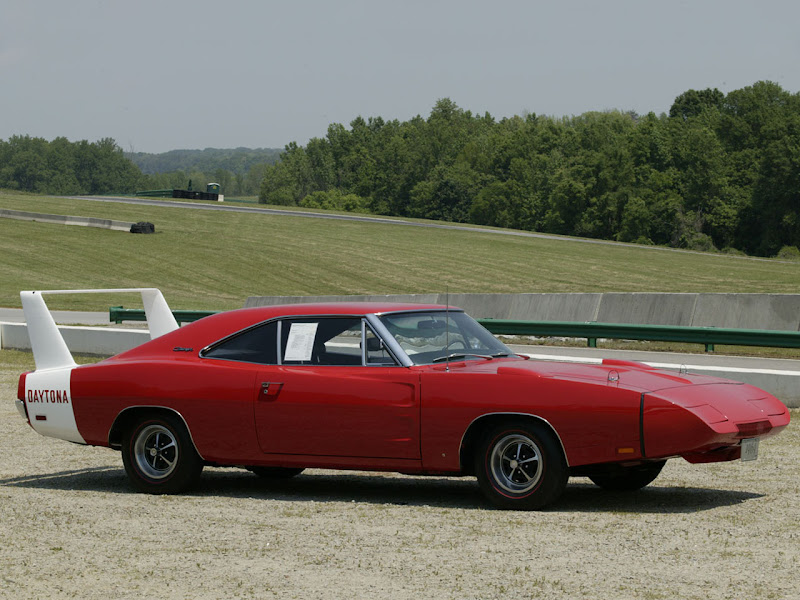.
By Eric Johnson
Last February, I alighted from a rental car in front of the massive grandstands that surround Daytona International Speedway. Affixed to these massive structures constructed of aluminum cross beams and steel girders were massive sepia-toned posters featuring great moments in NASCAR. One of them immediately caught my eye. The image was of the #40 Petty Enterprises Plymouth Superbird, driver Pete Hamilton behind the wheel, crossing the finish line in victory at Daytona in 1970.
While Daytona is now known as the stomping grounds of great drivers like Jeff Gordon, Jimmie Johnson, Kurt Busch and others, in 1970, the Superbird was the star attraction at the speedway. Reason being? It was the most outlandish, futuristic and downright frighteningly fast stock car to ever leave streaks of rubber on superspeedways such as the 2.5-mile, 31-degree banked tri-oval of Daytona and the 2.66-mile, 33 degree high banks of Talladega Superspeedway. An exercise in the fantastic, the Plymouth Superbird was brought to life for one reason and one reason only: To beat the then omnipotent Ford Torino Talladega. 
Throwing caution to the wind, Plymouth gathered around its finest engineers. Armed with T-squares and new technology. The engineers were told to ignore the accountants and immediately set about creating a stock car the likes Planet Earth had ever seen. Through their research and development efforts, the Superbird was designed aerodynamically by using a wind tunnel and computer analysis. Pure Detroit muscle, the Superbird’s body was silky smooth and seamless and graced with a shark-like front nose and a 23-inch high tail wing.
And with a 426-cubic inch big block dropped in the car, the Superbird cur through the air like an arrow, drivers like Richard Petty and Hamilton surpassing the 200 mile per hour mark like a NASA rocket. With Hamilton mashing the gas pedal into the floor, the Superbird won the first race it entered – the 1970 Daytona 500. So supernaturally fast was the Superbird that by 1971, NASCAR stepped in and restricted the car’s engine size, effectively clipping the Superbird’s wings. The car would effectively go the way of the dinosaur, but man alive, what a brilliant legacy it left behind.
Don’t believe the hype? Check out this YouTube segment.
skip to main |
skip to sidebar
Car Pictures, Car News, Entertainment, Tuning, Classic, Concept and Future Car
Popular Posts
-
Audi a3 2012 Audi a3 2012 Audi has pushed back the arrival of its next-generation A3 by one year as it tackles the development of several o...
-
The History Volkswagen Beetle was only produced in significant numbers from 1945 onwards, when the model was internally designated the Volks...
-
New 2012 Renault Duster is an antidote to that idea. With a length of 4.31 metres and a width of 1.82 metres, Renault Duster is very comp...
-
The new Volkswagen Polo GTI Character is often used as a synonym for assertiveness, confidence and aplomb: quite appropriate terms to descr...
-
The First generation Audi A5 is the third coupe in Audi's line-up, next to the second-generation TT and the R8. The A5 has adopted many ...
Blog Archive
-
▼
2009
(526)
-
▼
July
(31)
- Buco Jackets
- One picture One bike : SWM
- Spitfire & Norton : 2 British legends
- Walt Axthelm an Off-road Rider
- Ace Jacket : The G-1
- The Sunday Movie : 24 heures du Mans 1964
- Built for Speed
- Mad men : What are you waiting for ?
- HD Police Motors
- The Chase
- Apollo 11 Moonwalk
- B.S.A & Triumph Renewal
- Latecoere Flyingboats
- The Vintage Motocross Club of Western Australia
- If You Want to Be a Bird
- Brooks England since 1866
- Greeves Motorcycles
- Bell Helmet
- The Screamin’ Swede that Started a Racing Revoluti...
- The Sunday Movie : The Iron Horse
- Ducati 750 GT - 1970
- AGO at the Nürburgring 1968
- MV Agusta, a Legend
- When Harley went motocross racing
- Jay Springsteen's in Nagano
- Danny LaPorte the first FIM 250cc winner
- Oscar's Honey July 2009
- Italian Motocross Team in the 60's & 70's
- A Motocross History
- A Daredevil Legend : Bob Gill
- A Tribute to Farrah Fawcett
-
▼
July
(31)


 8:06 AM
8:06 AM
 Admin
Admin
 Posted in:
Posted in: 







